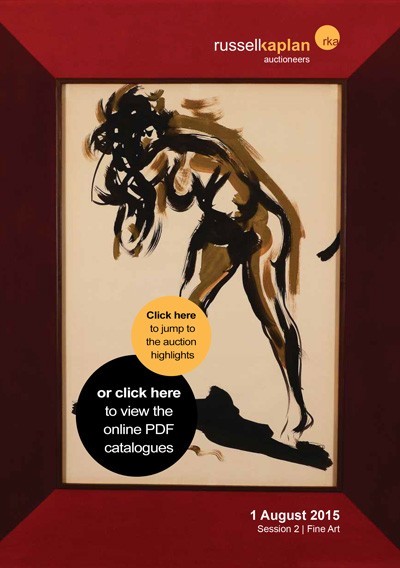Work of renowned Italian artist goes under the hammer in South Africa
Earlier this year an unsigned painting by Lucia Fontano, who in the 60s was one of the most well known artists in Europe, was sold in Milan for R440 000. A signed painting of a nude study by the same artist, a work from the same series is up for auction in South Africa and is estimated to fetch around R300 000 – R400 000. How did such a painting get to be in South Africa?
Lucio Fontana, Nude femminile, 1960, Ink on paper, 70 x 100,5 cm
The Zucci family emigrated from Italy to South Africa, following their passion for entrepreneurship, bringing the work with them. They brought it from their villa in Como which was developed by designer, artist and architect Ico Parisi. Fontano and Parisi would often collaborate.
Not only did Parisi design the architecture for the villa, he also considered the details including their interior furnishings including paintings on the walls. It was Parisi who designed and made the bold and unusual handmade frame of this painting, Nude femminile.
Says Russell Kaplan, the auctioneer, “We see that art pieces such as this retain their value in foreign currency. There is demand for this artist in Europe, and consequently works such as this are being bought as a rand hedge investment.”
This work will go on auction at Russell Kaplan Auctioneers on Saturday, 1 August 2015 and is available for viewing fromWednesday, 29 July until Friday 31 July. The full catalogue of this auction will be available online at www.rkauctioneers.co.za on Monday, 3 July.
Viewing takes place at the auction house corner Garden and Allan roads in Bordeaux.
Additional detail about this work and its provenance
Published in Barbero, L. M. 2013, Lucio Fontana, catalogue raisonné of the works on paper vol. III, p. 1061, r.
This charming nude study in an unusual handmade frame was made in the early 1960s, at the beginning of the counter-culture revolution, by Argentine-Italian artist and theorist, Lucio Fontana. At the time, Fontana was one of the most well-known and respected artists in Europe, who was at the cutting edge of the avant-garde.
In keeping with the spirit of the ideals in both life and art post World War II Fontana founded a movement in 1949, which he called Spatialism. Closely aligned with the impetus of Modern art, Fontana rejected the illusionistic quality of ‘traditional’ easel painting, opting instead for experiments with real space. The work he is mostly known for are his “Spatial Series” in which he lacerated the surface of monochrome canvasses. It is surprising therefore to find that alongside these radically conceptual works, he prolifically produced ‘traditional’ life studies in the form of drawings paintings and sculptures throughout his career. This nude female study is one of those works.
Rather than a departure from his conceptual work, however, we can understand this painting through a holistic lens. In some sense the expressive and powerful brushwork read like slashes through the picture plane: they have a particularly violent and aggressive quality to them that mimic the seemingly destructive act of piercing the surface of the canvas. Interestingly it was around the same time that Fontana began to reinvent the style that made him famous, choosing to work with impasto layers of oil paint, which he literally cut into producing abstract images.
In conversation with this potent nude study is a large lacquered, two-tone frame. It is not too often that the frame of an artwork becomes a point of conversation – in fact, strictly speaking the frame of an artwork should merely support the work, rather than collaborate or compete – but for this work, the frame adds another layer of meaning and another person to its story.
Fontana often collaborated with designer, artist and architect Ico Parisi. It is most likely that the two met through the Italian movement named Arte Povera, which loosely translates as “poor art”. Both artists were interested in disrupting the boundaries between art objects and non-art objects and the ways in which everyday life could be read as part of the artistic purvey. This was especially so for Parisi, whose practice not only included a diverse range of object-making including furniture, buildings and jewellery, but also fundamentally aimed at their integration. It was Parisi who designed and made the bold frame of this work and integrated it into the lives of the family with which it lived for most of its life.
Along with his wife, Luisa Aiani, Parisi founded a design studio called La Ruota in the beautiful town of Como, Italy. One of the earliest residential projects undertaken by Parisi in the 1950s was a set of neighbouring villas on the hills of Como in an area called Monteolimipino.
As explained by curator Adam Štěch, “The structures give a nod to the minimalist essentialism of Terragni’s pre-war rationalism, but also encompass unexpected, dynamic elements, such as overhanging surfaces, diagonal and beveled forms, and organic materials like stone slabs, nestled into the lush, suburban landscape” (Štěch, 2013). These homes embodied Parisi’s ideals of integration: not only did he design the architecture for each, he also considered the finest details including their interior furnishings down to the paintings on the walls. One of these villas belonged to the Zucchi family who acquired this painting through La Ruota.
Nude femminile then followed the Zucchi family to South Africa because of their passion for entrepreneurship in Africa.
Sources consulted:
http://arttimes.co.za/upcoming-auction-russell-kaplan-auctioneers-johannesburg-2/
Latour, B. 2012. The Berlin Key or how to do words with things. In Matter, Materiality and Modern Culture. Routledge. 10–21.
Štěch, A. 2013. Parisi in Como. Available: http://www.larcobaleno.com/stories/parisi-in-como.html [2015, July 20].
Upcoming Auction:
[button color=”accent-color” hover_text_color_override=”#fff” size=”medium” url=”http://www.rkauctioneers.co.za/” text=”View Now” color_override=””]
